Beginning and End of the Universe
Theories of the Universe (well, just one)
- The BIG BANG is our most compelling theory of the Universe. It explains many
cosmological observations. There are two main predictions from it that have held
true. These are the cosmic microwave background and the elemental abundance in the early
Universe (or Big Bang Nucleosynthesis).
- Since the Big Bang starts with an explosion that happens throughout the Universe, then
there must be residual light (or heat) from that explosion. And that light must be
everywhere. This is the cosmic microwave background.
- Since the Universe started out with such extreme temperatures, we can use our knowledge
of physics at high energies to model it. This will then tell us the exact elemental
abundances in the early Universe. These numbers have been well tested now and the predictions
agree amazingly well with the observations.
- The plot below shows the theoretical predictions for the relative amounts of the early
elements. These ratios are dependent on the total amount of baryonic matter. We now
have observational constraints on all of these quantities: the density of baryons and
abundances of Helium, Helium 3, Lithium, and Deuterium.
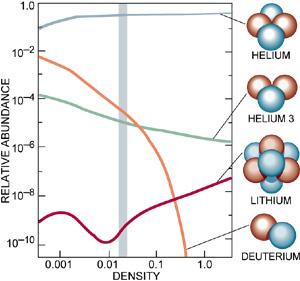
- Measuring these abundances is no easy task: we must observe objects that are uncontaminated
which generally means very distant objects. Quasars work best since they are very young.
Also, they are very far away and so their light can pass through many sources.
However, since we have many elements to work with we can get a very strict limit on
the baryon density. This value turns out to be around 0.04 of the CRITICAL DENSITY.
- The Big Bang Theory has been around since the 1920's. Lemaitre hypothesised it first using
Friedmann's solutions to Einstein's equations. However, there have been and still are many
other theories, but none as successful as the Big Bang. So, even though we don't understand
what makes up 90% of the Universe, we think we understand how it began. And that's a big
leap of faith.
Structure of the Universe
- The first requirement for the Universe structure is its mass. We will define everything
in terms of the CRITICAL DENSITY: that density which just balances the force from the
Big Bang. I.e., the critical density is that density which exactly counteracts the
expansion of the Universe (called a FLAT Universe). If the Universe had a higher density
then it would contract
back on to itself due to its gravity (called a CLOSED Universe). If it were lower then
the Universe would expand forever (called an OPEN Universe).
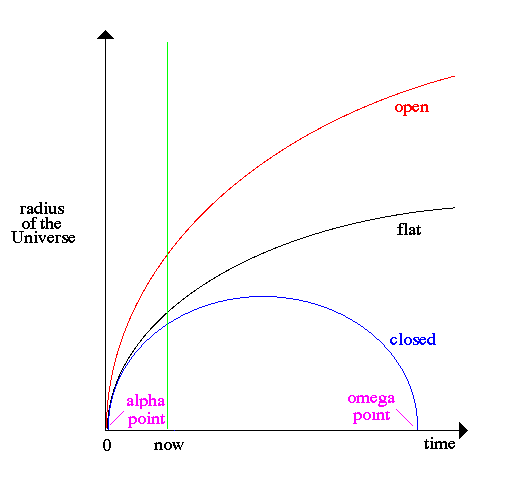
- The consensus now for the Universe is called an ACCELERATING UNIVERSE.
Not only is the universe going to expand with time, but it will expand faster
and faster as we age. Eventually, everything will be pushed away from each other
to the point where we don't even see other galaxies anymore.
- This is due to an energy called DARK ENERGY. It is the energy of empty space. This
force causes the existence of space to have a negative pressure, which means that
it pushes out on the space (gravity on the otherhand causes mass to come together).
Noone understands where this comes from (theoretically) but we can measure it's effect.
- There are strong theoretical arguments for having the density equal to the critical
density, but they are mainly philosophical. For example, during inflation the Universe
expanded 10^25 times in a matter of 10^-33 seconds. Such an enormous expansion will
cause everything to look flat and we must be pushed towards the critical density.
- If you don't like the philosophical argument, then we now have very strong observational
measurements from the cosmic micorwave background.
- Boomerang provided a
strong observation that the Universe is flat (at critical density). Here is a pretty
picture of Boomerang and the CMB sky over Antartica.
- In 2001, Boomerang announced the angular spectrum of the CMB radiation. The plot
below is their data. This plot tells us that regions of the sky that are seperated
by 1 degree are very correlated (they know about each other). If the Universe had
a lot of mass then many more regions would be correlated much stronger. If it had
little mass, then very few regions would be correlated.
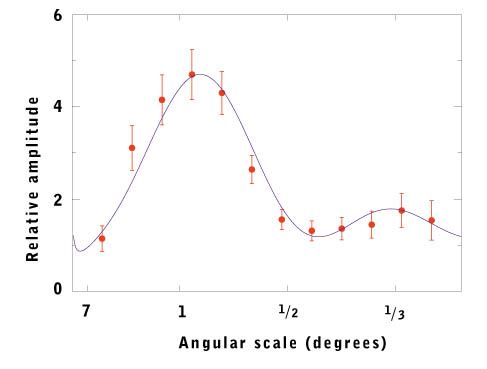
- This plot below shows model results if the Universe were closed (left), flat (middle),
or open (right).
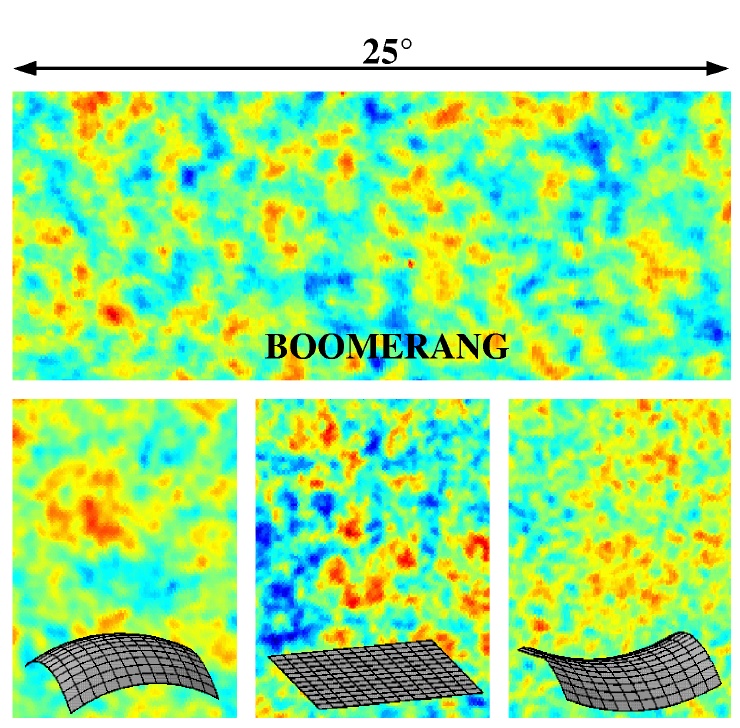
- The best fit to the Boomerang data suggest that the Universe is at the critical density.
This is a remarkable match between theory and observation. However, it does not tell
us what the Universe is made up off: it only tells us the total density. Thus, there
is still a degeneracy between the cosmological constant and the matter density.
- Here's where the cosmological constant steps in: the supernovae measurements suggest
that the cosmological constant is equal to 0.73 times the critical. Thus, the matter
density must therefore be equal to 0.27 such that their sum is equal to 1.0. The plot
below shows the results from supernovae and Boomerang:
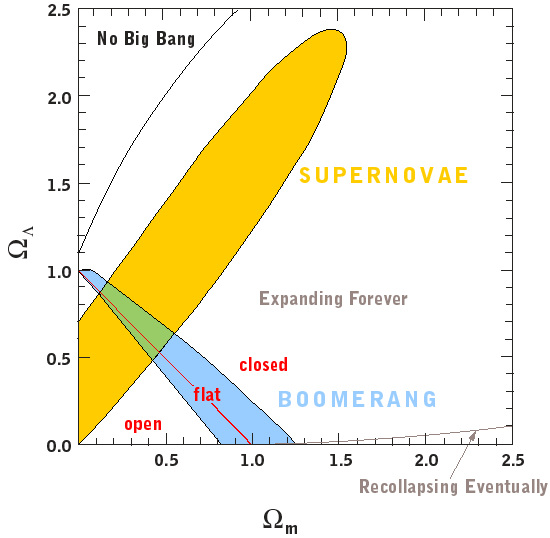
- What is still missing though is that we do't know how to seperate the mass into
baryonic and non-baryonic mass. Here we use Big Bang Nucleosynthesis measurements.
They tell us that baryonic matter is around 0.04 of critical. Since we think that
the total matter density is equal to 0.27, then we are missing 0.23 of mass: THIS
IS THE DARK MATTER!
- It tells us that the missing mass cannot be made of baryons completely or we will
violate Big Bang Nucleosynthesis.
- This was the story as of Jan 2003. In Feb of 2003, WMAP
announced their result. WMAP had significantly better signal than the previous
CMB experiments, and thus obtained a better picture of the Universe.
Here is the WMAP CMB Universe .
Below is the WMAP spectrum of the CMB:
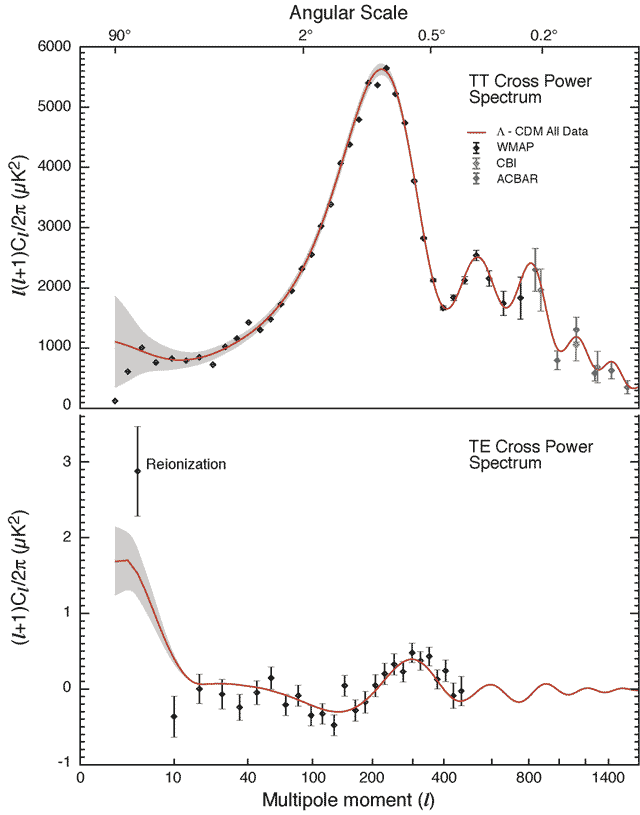
Here's a comparison between the 3 major CMB experiments:

- We are living in a special time in the history of Astronomy: we are witnessing the
understanding of the basic parameters of the Universe!
- The CMB experiments don't do everything though. For example, they don't explain the
structure that we see in terms of galaxies and galaxy clusters. The scale of the
CMB experiments are too large still to see at this level. So, what it implies
is that we need something other than the temperature fluctuations to make the structure
that we know. So the peaks in the CMB plots may actually
refer to the tip of the icebergs in terms of matter fluctuations.






